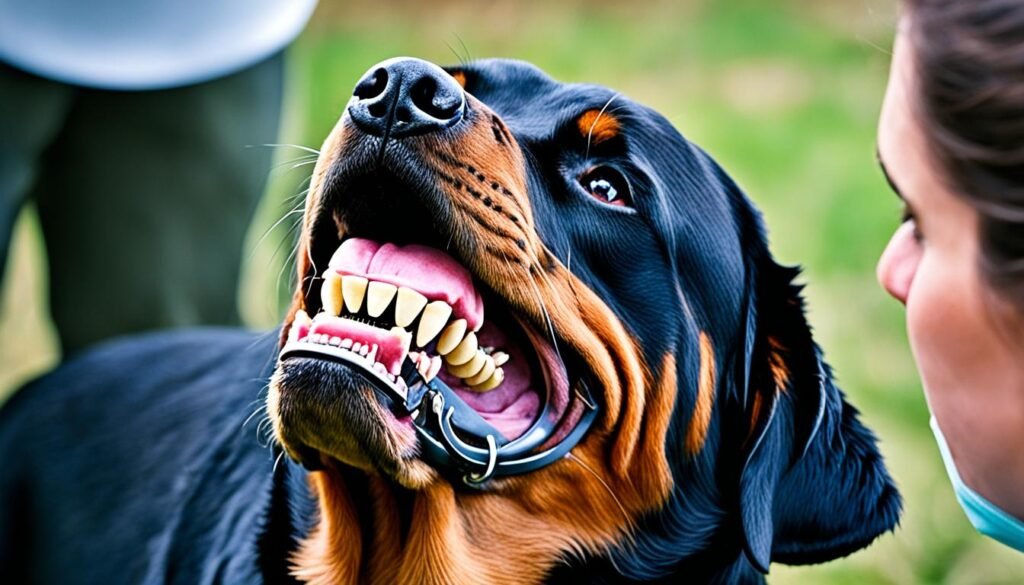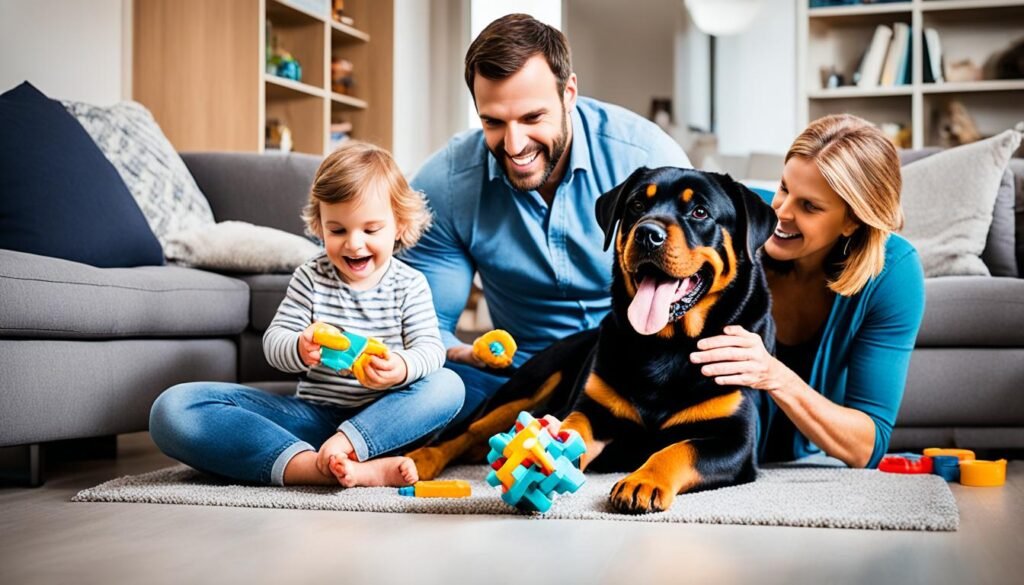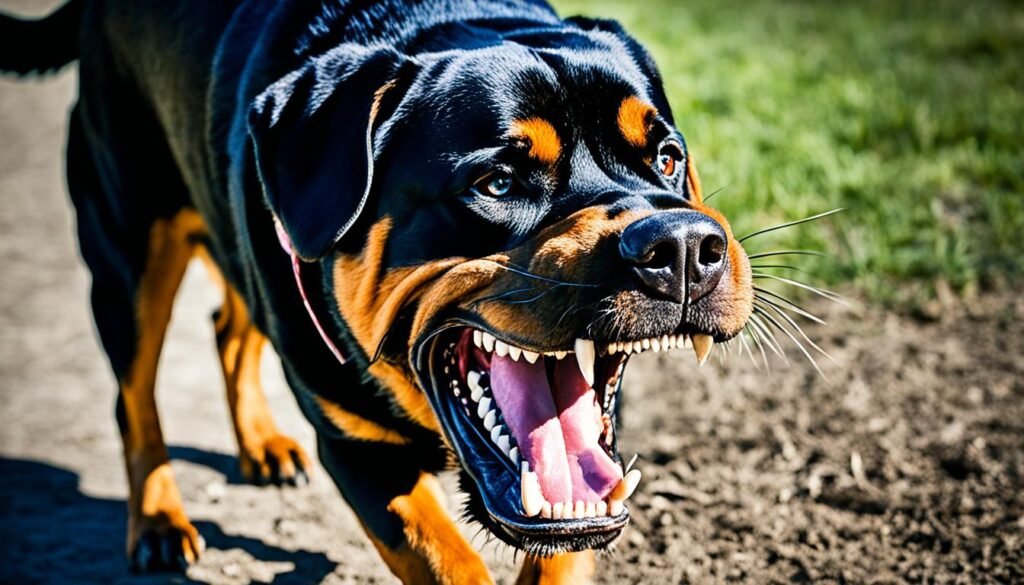Hi there! In this article, I’m excited to delve into the fascinating world of Rottweiler bite force. Have you ever wondered just how powerful a Rottweiler’s bite really is? Well, you’re about to find out!
Key Takeaways:
- The bite force of a Rottweiler can exert between 320 to 328 pounds per square inch (PSI).
- Proper training and socialization are crucial in preventing biting incidents.
- Rottweilers can be loyal and protective, but their behavior depends on various factors.
- Seek immediate medical attention for Rottweiler bites due to the potential severity of the injury.
- Adopting a Rottweiler requires understanding the breed’s characteristics and commitment to training and care.
The Anatomy of a Rottweiler's Bite
A Rottweiler’s jaw strength is not solely determined by its size, but by a combination of factors including skull structure, muscle composition, and historical breed purposes. Rottweilers were originally bred for herding livestock and pulling carts, which required a strong and powerful bite. This breed has a bite force that can exert between 320 to 328 pounds per square inch (PSI), making it one of the strongest bites among domestic dogs.
The power of a Rottweiler’s bite is a result of their robust jaw muscles and the structure of their skull. These physical attributes allow them to exert a tremendous amount of force when biting, making them capable of inflicting significant damage if provoked or threatened.
In addition to their jaw strength, Rottweilers also possess a strong bite pressure. This pressure is a measure of the force generated by the contraction of their jaw muscles. With their powerful bite, Rottweilers are capable of puncturing and crushing bones, making them formidable protectors and working dogs.
It’s important to understand that a Rottweiler’s bite power does not necessarily indicate aggressive or dangerous behavior. With proper training, socialization, and responsible ownership, Rottweilers can be loving and gentle companions. However, it is essential to respect their strength and always handle them with care and caution.
Why Rottweiler Bites Can Be Dangerous

The bite force of a Rottweiler is not only impressive, but it can also be dangerous. With a bite force ranging from 320 to 328 pounds per square inch (PSI), a Rottweiler’s bite has the potential to cause severe injury, including broken bones and tissue damage.
Approaching a Rottweiler with caution and respect is crucial, as their bite can be extremely powerful when provoked or agitated. It’s important to remember that Rottweilers have a strong instinct to protect their owners and territory, which can sometimes lead to defensive behavior.
Understanding the Study on Rottweiler Bite Strength
- The study conducted on Rottweiler bite strength involved measuring the bite force of a sample group of Rottweilers using specialized equipment.
- Researchers found that Rottweilers have a bite force that ranges from 320 to 328 PSI, which is among the highest recorded bite forces for domestic dogs.
- This study emphasizes the importance of recognizing the potential danger of a Rottweiler’s bite and taking appropriate precautions to avoid unnecessary risks.
While these statistics may seem alarming, it’s important to note that responsible ownership, proper training, and socialization can greatly reduce the risk of biting incidents. Rottweilers can be loving, loyal companions when given the attention and care they need.
Factors Influencing Rottweiler Biting Behavior

When it comes to Rottweilers and their biting behavior, it’s important to understand that such tendencies are not inherent to the breed. Several factors influence how a Rottweiler behaves in terms of biting, including their temperament, training, and socialization.
Rottweilers are known to be protective and loyal, which can sometimes be mistaken for aggression. However, with proper training and socialization from an early age, unwanted biting behavior can be prevented, ensuring a well-behaved and balanced Rottweiler.
Temperament plays a crucial role in a Rottweiler’s behavior. Each dog has its own unique personality, and some may be naturally more prone to exhibiting aggressive behaviors. It’s important to assess the individual temperament of a Rottweiler and provide appropriate training and socialization to address any potential issues.
Training is key in managing a Rottweiler’s biting behavior. By implementing positive reinforcement techniques and establishing clear boundaries, owners can teach their dogs acceptable behaviors and discourage any biting tendencies. Consistency, patience, and rewarding good behavior are essential components of effective Rottweiler training.
Socialization is equally important in shaping a Rottweiler’s behavior. Exposing them to various environments, animals, and people from a young age helps them become well-adjusted and less likely to resort to biting. Proper socialization also helps Rottweilers learn appropriate ways to interact with others, reducing the risk of aggressive behaviors.
Training and Socialization for Preventing Biting
To minimize the risk of biting incidents, proper training and socialization are crucial for Rottweilers. Training from an early age helps them develop appropriate behaviors and understand boundaries. Positive reinforcement techniques, such as rewards and praise, can be highly effective in teaching a Rottweiler the desired responses.
Socializing your Rottweiler to various environments, animals, and people is also essential. Exposing them to different situations and interactions helps them become well-adjusted and less likely to resort to biting when faced with unfamiliar circumstances. It allows them to develop confidence and good manners around other dogs, strangers, and children.
During socialization, it’s important to introduce your Rottweiler gradually and in a controlled manner. Start with low-stress environments and then gradually expose them to more challenging situations. Observe their reactions and body language, and provide a safe and supportive environment to help them navigate new experiences.
When training and socializing a Rottweiler, consistency and patience are key. It’s important to set clear boundaries and establish yourself as the pack leader. This helps them understand what behaviors are acceptable and what are not. By providing proper training and socialization, you can raise a well-behaved and confident Rottweiler.
Tips for Rottweiler Training and Socialization:
- Start training your Rottweiler as early as possible to establish good habits from the beginning.
- Use positive reinforcement techniques, such as treats, praise, and toys, to reward desired behaviors.
- Be consistent in your training methods and expectations.
- Expose your Rottweiler to different environments, including parks, busy streets, and dog-friendly establishments.
- Introduce your Rottweiler to new people, children, and animals in a controlled and positive way.
- Attend obedience classes or seek guidance from a professional dog trainer if needed.
By investing time and effort into training and socializing your Rottweiler, you can raise a well-adjusted and obedient companion. Remember, a properly trained and socialized Rottweiler is less likely to resort to biting behavior and more likely to bring joy and love to your life.
Dealing with Rottweiler Biting Incidents

In the unfortunate event of a Rottweiler bite, immediate action must be taken to address the potential severity of the injury. The first and most crucial step is to seek immediate medical attention for yourself or the affected individual. Rottweiler bites can cause significant harm, including deep puncture wounds, tissue damage, and fractures, which require professional medical treatment.
It is also important to report the incident to the appropriate authorities as required by local regulations. Reporting ensures that the incident is documented, and necessary actions can be taken to prevent future incidents and protect public safety.
For Rottweiler owners, dealing with a biting incident goes beyond the immediate aftermath. It is essential to reassess your dog’s training and living conditions to prevent future biting incidents. Reflect on the circumstances leading up to the incident and consider whether there were any warning signs or triggers that should have been addressed earlier.
Consulting with a professional dog behaviorist can provide valuable insights into the underlying causes and help develop strategies to prevent future incidents. They can assess your Rottweiler’s temperament, identify any behavioral issues, and offer guidance on training techniques and socialization to prevent biting incidents from occurring again.
It’s important to remember that every Rottweiler is an individual, and understanding their unique needs is crucial to ensure their well-being and the safety of those around them. By taking appropriate measures and seeking professional guidance, we can work towards a safer and more harmonious relationship with our Rottweiler companions.
Considering Rottweiler Adoption

Adopting a Rottweiler requires careful consideration and a deep understanding of the breed’s characteristics. Rottweilers can make excellent family pets with the right training and socialization. However, it is important to note that they may not be suitable for first-time dog owners or individuals who are not willing to invest time and effort into their training and care.
To ensure a successful ownership experience, it is crucial to have a good understanding of dog behavior and a commitment to provide the necessary training and exercise for a Rottweiler to thrive. These dogs are known for their strength and intelligence, which require proper channeling through structured training and mental stimulation. Consistency, patience, and positive reinforcement are key when working with this breed.
When adopting a Rottweiler, it is essential to prioritize their socialization. Exposing them to a variety of people, animals, and environments from a young age can help them develop good manners and become well-adjusted members of society. Additionally, obedience training can establish boundaries and reinforce desired behaviors.
It’s important to keep in mind that Rottweilers have specific needs when it comes to exercise. Regular physical activity and mental enrichment are vital to their overall well-being. Be prepared to provide them with daily walks, playtime, and opportunities for mental stimulation such as puzzle toys or training sessions.
Before bringing a Rottweiler into your home, consider your living situation and available space. Rottweilers are active dogs that require ample room to move around and explore. Access to a securely fenced yard or nearby parks where they can burn off energy is highly beneficial.
Remember, adopting any dog is a long-term commitment, and Rottweilers are no exception. They thrive in homes where they are considered a part of the family and receive the love, attention, and care they deserve. By adopting a Rottweiler, you are making a commitment to their well-being and providing them with a forever home.
Benefits of Rottweiler Ownership
- Rottweilers are known for their loyalty and protective nature, making them excellent family guardians.
- With proper training and socialization, Rottweilers can be loving and affectionate towards their families.
- They are intelligent and eager to please, making them highly trainable.
- Rottweilers often form strong bonds with their owners and can be incredibly devoted.
- Despite their strong exterior, Rottweilers can be gentle around children when properly socialized.
Conclusion
In conclusion, the Rottweiler’s bite force is undeniably powerful and has the potential to cause significant injury. However, it is important to note that this does not mean that Rottweilers are inherently aggressive or more prone to biting than other breeds.
Proper training, socialization, and responsible ownership are key factors in preventing biting incidents and ensuring that a Rottweiler’s strength is directed in a positive and controlled manner. By providing a loving and structured environment, Rottweilers can grow up to be loyal and well-behaved companions.
It is crucial to understand the unique characteristics and needs of the Rottweiler breed before considering adoption. Rottweilers require dedicated owners who are committed to their training and ongoing care. With the right approach, a Rottweiler can thrive as a part of the family, bringing joy and companionship to their owners.
FAQ
What is the bite force of a Rottweiler?
A Rottweiler’s bite force can range from 320 to 328 pounds per square inch (PSI).
How powerful is a Rottweiler’s jaw strength?
A Rottweiler’s jaw strength is determined by factors such as skull structure, muscle composition, and historical breed purposes.
Why are Rottweiler bites dangerous?
Rottweiler bites can be dangerous because of their high bite force, which can cause severe injury including broken bones and tissue damage.
Are Rottweilers prone to biting?
Biting tendencies are not inherent to the Rottweiler breed. Training, socialization, and individual temperament play a significant role in a Rottweiler’s behavior.
How can I prevent Rottweiler biting incidents?
Proper training and socialization from an early age are crucial in preventing unwanted biting behavior in Rottweilers.
What should I do if a Rottweiler bites?
In the event of a Rottweiler bite, seek immediate medical attention and report the incident as required by local regulations. Reassess the dog’s training and living conditions to prevent future biting incidents.
Is a Rottweiler a suitable breed for adoption?
Rottweilers can make great family pets with proper training and socialization, but they require commitment, time, and effort from their owners.
